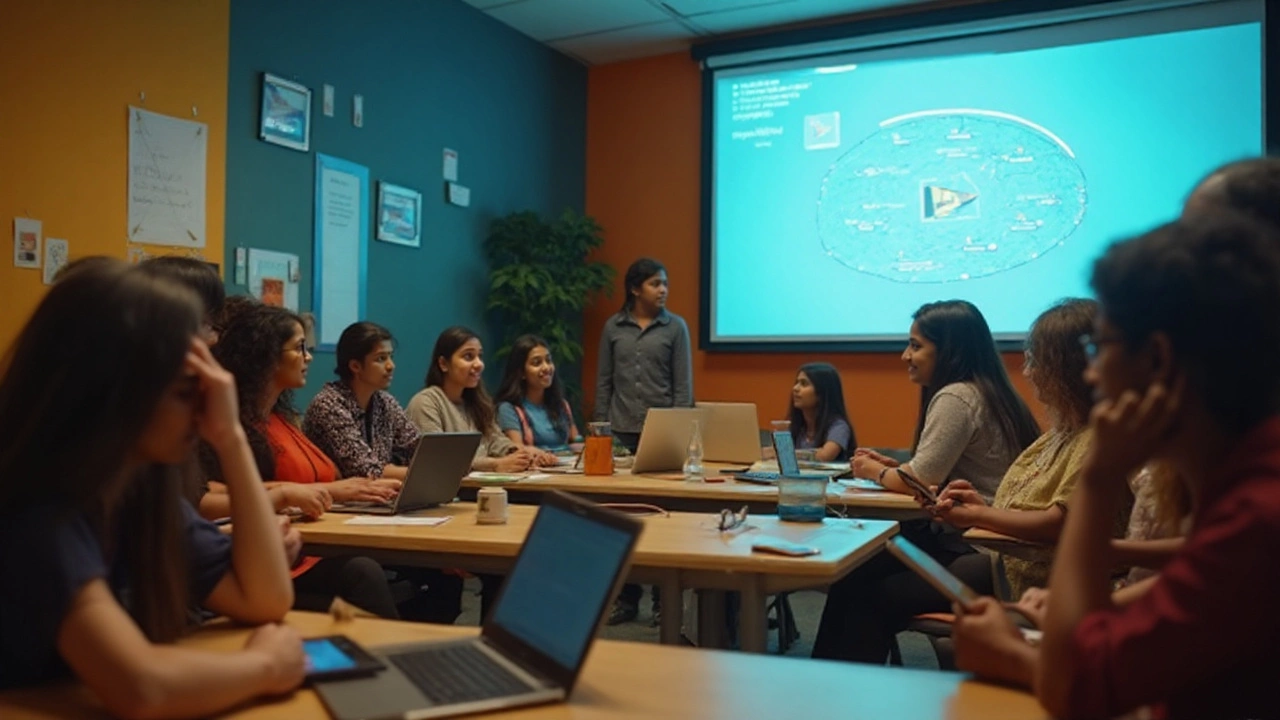
Picture a world where the classroom stretches far beyond four walls. Where your teacher could be on a different continent, and your classmates log in from three time zones away. That’s not science fiction—that's just a Tuesday in modern eLearning. The traditional classroom is taking a back seat, not just because of tech advances, but because the way we work, live, and want to learn is changing. It’s exciting, convenient, sometimes a little messy, but it’s definitely the future. But with online education booming (the global eLearning market is predicted to hit $375 billion by 2026, according to Statista), how do students and organizations decide what approach to pick? The answer lies in the model.
The Big 5: Understanding the Major eLearning Models
The world of eLearning is crowded with buzzwords—synchronous, asynchronous, blended, flipped, and self-paced. It can get confusing pretty quickly, especially when these ideas overlap. Still, each of these five models puts a unique spin on how learning is structured, delivered, and received.
eLearning models aren’t just academic theory. They shape how lessons are planned, how you interact with your teacher, and even how you’ll feel about learning itself. The five main types are:
- Synchronous eLearning: Real-time. Think live Zoom classes, webinars, or group chats at a set hour.
- Asynchronous eLearning: Learn anytime. Includes recorded lectures, discussion forums, and self-guided modules.
- Blended Learning: A mix of online and face-to-face—virtual resources plus in-person sessions.
- Flipped Classroom: Students review material online first, then use class time for questions and problem-solving.
- Self-paced Learning: No deadlines, no fixed schedule. Learners chart their own course, even if it takes months.
Let’s pull apart each one to see what it looks like in real life, when it works best, and what you should watch out for.
Synchronous eLearning is kind of the closest thing to the traditional classroom—except there’s no chalk dust. Everyone logs in at the same time and interacts in real time. It’s great if you love immediate Q&A, guided activities, and that feeling of a scheduled event. But it can be tough with tight schedules or time zones: if your biology teacher is in Mumbai and you’re in California, someone’s learning at 2AM.
Asynchronous eLearning puts the calendar in your hands. Watch video lectures when you want, pause to take notes, contribute to forum discussions on your own time. This works brilliantly for independent folks juggling jobs, family, or odd hours. It does require discipline—no one’s nudging you to log in. Completion rates can dip if motivation isn’t high.
Blended Learning is the classic hybrid: some lessons in-person, the rest online. Imagine a university class where you meet on campus twice a month for labs, then finish readings and quizzes online. It captures the social element of learning while keeping the flexibility of digital tools. Several studies show test scores and engagement often improve with this format, because learners get the best of both worlds.
Flipped Classroom: this one flips the whole idea of "homework." Students first engage with material—usually via video, podcast, or reading—at home. When they come to class (physical or virtual), instead of listening passively, they tackle group discussions, activities, or problem-solving. It builds critical thinking skills but only works if everyone actually prepares ahead of time. A 2022 survey by the Flipped Learning Network found that 75% of educators saw more student participation in flipped settings than with lectures alone.
Self-paced Learning removes deadlines. Learners go at their own speed, retaking modules if needed. It’s common in professional development or microlearning platforms like Coursera and Udemy. Some people breeze through in a week; others chip away over months. The danger? It’s easy to procrastinate. Still, this model is a lifeline for adult learners or anyone facing unpredictable schedules.
| Model | Best For | Example Platforms | Challenges |
|---|---|---|---|
| Synchronous | Team-oriented learning, real-time feedback | Zoom, Google Meet, Blackboard Collaborate | Time zone differences, tech hiccups |
| Asynchronous | Flexibility, self-motivation | Moodle, Canvas, YouTube | Low engagement risk, weaker community |
| Blended | Hands-on activities, social learning | EdX, Coursera (with campus sessions) | Coordination complexity |
| Flipped | Active learning, deep discussions | EdPuzzle, Google Classroom | Prep time, unprepared learners |
| Self-paced | Adult learners, niche topics | Udemy, LinkedIn Learning | Procrastination, isolation |
Quick tip: Picking a model isn’t just about technology. Think of your goals, learning style, and the time you can realistically commit. Short courses on new skills? Self-paced is your friend. Want regular feedback and a sense of class community? Try synchronous or blended. Struggling with motivation? Blended or flipped models give just enough structure to stay involved without feeling forced.

How These Models Shape Real-World Learning
Schools, universities, edtech startups, and even Fortune 500 companies are all mixing and matching these eLearning models. It’s not just about education—upskilling at work, remote onboarding, and even government training modules use them.
During the pandemic, 1.2 billion students globally switched to some form of online learning. The chaos highlighted what worked: teachers quickly realized a straight copy-paste from classroom to Zoom flopped. Engagement dropped, students zoned out, and learning suffered. That's when models like flipped classroom and blended learning started to shine. For example, the Delhi Public School system integrated a hybrid approach, mixing live teacher sessions and pre-recorded videos, and reported a 15% increase in assignment completion.
Flip the lens to the working world. Big companies aren’t just uploading PDFs for new hires. IBM famously calculated that switching to eLearning shaved off 40% of employee training time and boosted retention rates by nearly a third. How’d they do it? A blend of synchronous workshops for Q&A, self-paced modules for knowledge, and discussion forums to swap insights. Everyone could learn at their own speed, but still felt like part of a team.
It’s not all sunshine, though. A 2023 MIT study found that self-paced MOOCs had a completion rate below 10%. Motivation away from deadlines is a real challenge. The best platforms now nudge you with reminders, leaderboard points, or badges to keep things interesting.
Here’s a quick case: A Bangalore-based IT training academy used a flipped model for coding bootcamps. Students tackled coding challenges at home, brought their bugs and questions to live sessions. Over six months, job placement rates jumped 22% compared with previous lecture-based models. Turns out, tackling real problems together in class built skills that actually stuck on the job.
And don’t overlook blended learning in rural or underserved communities. In parts of Uttar Pradesh, government schools blend radio lessons and smartphone quizzes to work around lack of reliable internet. Studies have shown students in these setups keep up better than those with online-only options, thanks to community teachers filling the gap.
Tips for making these models work for you: Start with your end goal. If you need a certificate for work, look for self-paced but structured courses with clear milestones. Want to switch careers or need peer support? A blended cohort with regular check-ins keeps you on track. Use forums, chat groups, or study buddies—social learning helps engagement, whichever model you pick. Don’t ignore tech support needs: a dead laptop the night before an exam isn’t just bad luck, it’s a preventable disaster if you prep with backups or mobile access apps.
Data backs all this up. The U.S. Department of Education reported that students in online/blended classes performed slightly better, on average, than those in face-to-face only settings. It’s not about replacing teachers or classrooms; it’s about expanding what learning can look like.

Choosing the Best eLearning Model for Different Learners
No single eLearning model is right for everyone. What works for a working mom learning at midnight won’t fit a college freshman craving face-to-face debate. The secret? Customization. A study published by the International Review of Research in Open and Distributed Learning in April 2024 found student satisfaction doubled when they could choose or customize their eLearning model.
So, how do you sort through your options? Start by checking your needs against the strengths and weaknesses of each approach.
- Need structure and group support? Go synchronous or blended.
- Juggling unpredictable schedules? Asynchronous or self-paced fits better.
- Love to interact but hate lectures? Flipped classroom puts you at the center.
- On a shoestring budget or inconsistent internet? Blended, radio, or download-and-go modules reduce your risk.
Age can play a role. Younger learners usually need more human interaction—hence live classes or blended setups work best. Adult or professional learners, used to managing their own time, thrive in self-paced contexts but benefit from community elements and spaced check-ins.
One tip—don’t be afraid to mix and match. Many platforms now let you go asynchronous most of the time, but join live discussions for key topics or deadlines. Some even offer AI-driven personalized learning paths, shifting harder topics into more interactive formats while letting you whiz past what you already know.
Accessibility matters too. The best courses use closed captions, offer transcripts, and design mobile-first. A 2023 report from Class Central notes that 26% of all MOOC engagement now happens via smartphones, especially in India. So mobile-friendly models aren’t just a bonus—they’re often essential.
Some quick “pro tips” as you choose or design eLearning:
- Check the level of support—forums, mentor chats, or 24/7 help can rescue you from tough spots.
- Sampling matters. Start with free modules or trial periods before committing big money.
- Look for courses that fit your real schedule. If you travel, favor models offering downloadable content or app-based modules.
- Measure your progress. Good eLearning models give you dashboards or progress bars to see how far you’ve come—and how far you’ve got to go.
As eLearning grows, people are getting pickier about what format works for them. University admissions now consider online course grades. Employers weigh digital badges as much as degrees. In the next five years, don’t be surprised if your teacher or manager asks you to help pick the right model. The good news—they’re easier to understand when you know the choices.
